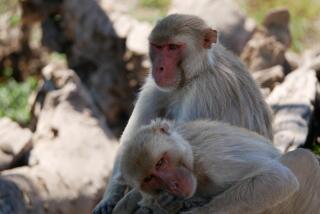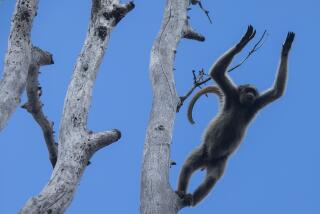Wild monkeys make sharp stones that look like human tools, study finds
- Share via
It does not pay to underestimate a monkey with a rock.
Scientists studying the stone-smashing habits of bearded capuchin monkeys in Brazil have found that the primates inadvertently produce stone flakes that look very similar to the flakes used as cutting tools by early humans.
The findings, published this week in the journal Nature, could complicate throw a snarl in the links that paleoanthropologists make between early Stone Age artifacts and the emergence of primitive human technology.
“It does raise interesting questions about the level of cognitive complexity — how intelligent a hominin has to be in order to produce what we thought was a sophisticated technology,” said study leader Tomos Proffitt, a paleoanthropologist at Oxford University.
When anthropologists explore early human settlements, they typically search for signs of tool use, whether by looking at the cuts on butchered animal bones or finding the tools themselves.
Some of the earliest tools were simply stone flakes — sharp-edged fragments that were knocked off of a rock by hitting it with another rock at a tangential angle. Such shaped stones are seen in the archaeological record in Africa well over 3 million years ago. These stone flakes were later refined into Stone Age tools known as hand-axes — typically teardrop-shaped, with a rounded end for gripping and a sharp end for cutting.
The fragments have a number of telltale characteristics, the study authors pointed out. They usually feature what’s known as “conchoidal flaking,” a type of fracture pattern that doesn’t really occur naturally. They also feature sharp cutting edges. At human sites, multiple flakes are usually found from the same original rock, because a human toolmaker would often knock several off. These and a few other characteristics, taken together, are seen as signs of intentional human behavior.
Humans are not the only species to use tools — crows, elephants and a number of primates have been documented using them in the wild. Chimpanzees wield stones as hammers to crack nuts. While their stone-smashing might occasionally result in shards, those do not quite look like the flakes that ancient hominins created.
Then an Oxford-led team of researchers went to the Serra da Capivara National Park in northeastern Brazil to study the rock-smashing habits of wild bearded capuchin monkeys. These monkeys (known formally as Sapajus libidinosus)use stone tools for a wider variety of activities than any nonhuman primate, the researchers said — for pounding food, digging, and in sexual displays. But capuchin monkeys also seem to do something that no other wild primates do — smash the stones in order to damage them.
The scientists watched as the monkeys took quartzite stones and used them as hammers to clobber quartzite cobbles embedded in the ground, and then apparently licked or sniffed crushed dust from the damaged rock. In the process, they ended up breaking flakes off the hammer stones, which the scientists then gathered and sent to Proffitt.
“As soon as I saw this material, it was pretty clear that it was something quite special that needed to be examined,” he said.
The flakes featured sharp edges and conchoidal fracturing. And multiple flakes seem to have been pounded off the same rock core — just as an early human might have done.
Even though flakes that were created by the capuchins looked remarkably like those created by ancient humans, the capuchins don’t seem to have any interest in using the sharp edges, Proffitt added. They mostly seem interested in licking up the rock dust.
If the process of knocking stones together to make a specific product can no longer be considered a human-specific practice, this creates something of a conundrum, said Hélène Roche of France’s National Center for Scientific Research, who was not involved in the study.
“Previous evolutionary explanations for the origins of hominin intentional stone modifications have focused on hominin-specific advances, such as changes in hand shape, coordination and cognitive skills,” she wrote in a commentary. “Explaining the origins of intentional stone modifications by early hominins in light of Proffitt and colleagues’ interpretation of their results would therefore require alternative hypotheses.”
In other words: Scientists can no longer fully depend on the shape of these stone flakes to make inferences about the development of early humans’ intelligence and dexterity. Those ideas will have to be refined once again, to make sure that the clues scientists look for are truly specific to early humans, and not other primates.
But that doesn’t mean researchers have to re-evaluate everything, she was quick to add.
“Our knowledge about technical behaviours and stone knapping in early-human archaeological sites has a solid foundation,” she wrote.
Scientists study primate behavior because it could help them understand the practices of our early human ancestors, said Sonia Harmand, an archaeologist at Stony Brook University who was not involved in the study.
“The first hominin tools could have really looked like the ones produced by capuchins or great apes,” she said.
But it’s one thing to make a flake, and it’s quite another to actually put it to use.
“After creating a sharp-edged flake accidentally, the success is when you realize that this flake can be useful,” she said. “At one point [in human history], it happened. And this is not something we see with the capuchin. ... The intention is very different.”
Harmand said studying the monkeys’ behavior in greater detail — and widening the net to include other capuchin populations — would be a useful next step. Were the flake-creating behaviors occasional, or very routine? Were the practices of other capuchin communities the same, or not?
“I would love to know if they can find other groups of capuchin doing that,” she said.
As for why the capuchins smash rocks together and eat the dust, that remains something of a mystery, Proffitt said. It could be that they’re trying to ingest the dust because it contains necessary trace minerals, or the lichen on the rocks has antimicrobial properties. Perhaps the tiny shards of quartzite dust actually help shred parasites in their gut. There are plenty of theories so far, but no clear answers.
“To be honest, we have absolutely no idea why they’re doing it,” he said. “We’re hoping to look at this behavior in more detail.”
Follow @aminawrite on Twitter for more science news and “like” Los Angeles Times Science & Health on Facebook.
MORE SCIENCE NEWS
See how beautiful the world can look through a microscope
Science explains why refrigerators sap the flavor from ripe tomatoes
5,000 years ago, rodents were apparently considered food in part of Europe
UPDATES:
Oct. 21, 1:10 p.m.: This story has been updated with additional comment from Sonia Harmand.
This story was originally published Oct. 19 at 10:05 a.m.







